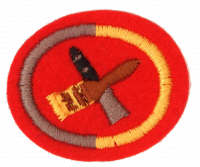Especialidades JA/Pintura interior de casas/Respuestas
Nivel de destreza
3
Año
1938
Version
29.05.2024
Autoridad de aprobación
Asociación General
1
- a. Tinte
- b. Barnizado
- c. Pintura
2
When you stipple, a glaze coat of one color is applied and then textured, revealing the undercoat of a base color. In both cases, a glaze is mixed with latex paint at a 5:1 ratio (five parts glaze, one part paint). Stippling should be done in small sections moving from the top of the wall to the bottom so that if there are drips or runs, it will not ruin the work already completed.
3
A paint spray gun should be used when painting highly textured surfaces. Examples of textured surfaces include stucco, cinder blocks, and rough-hewn lumber. These are very difficult (but not impossible) to paint with a roller or a brush.
4
Proper cleaning starts before you begin to paint. If using a water-soluble paint, dip the brush in water. If using a paint (or varnish) that is not water-soluble, dip the brush in whatever solvent is called for. Then shake the brush to remove excess water (or solvent). Once this is done, you are ready to dip the brush in the paint for the first time.
When you are finished painting, run water over the outside of the brush, letting it flow away from the brush's ferrule and off the tip of the bristles. Then fill an empty, clean paint can (or bucket) halfway with water and add a couple tablespoons of dish washing liquid. Swirl the brush around in the soapy water, but do not jab the bristles into the bottom of the can. This will cause the bristles to develop permanent bends.
Rinse the brush in a second can (or bucket) of clear water. If the rinse water clouds up, return to the soapy water, and then rinse again. Repeat until the rinse water does not cloud up. Hang the brush to dry by the hole drilled in the tip of its handle.&
5
Putty is used to fill nail holes an blemishes in door and wind facings, baseboards, and crown moldings. It should have the consistency of paste. Tear off a small ball of putty and push it into the hole with your finger. Then, still using your finger, wipe it away, so that some is left in the hole, but the top is even with the surface of the wood. Allow the putty to dry before painting.
6
7
Bright colors make it difficult to relax in a room, so they should be avoided in most interior spaces.
Adventist Youth Honors Answer Book/Color Schemes/es
8
8a
8b
9
The woodwork includes the baseboards, door frames, window frames, and crown molding. This requirement suggests that the woodwork be painted a different color than the walls. It could also have a natural finish (such as varnish).
10
Paint belongs on the walls and ceilings. It does not belong on the floor, windows, outlet and switch covers, door knobs, latches, or hinges. Nor does it belong on light fixtures, smoke detectors, sprinklers, art work, mirrors, telephones, appliances, or furniture.
If the woodwork is to have a finish distinct from the walls, paint does not belong there either.
How do we keep paint where it belongs?
- Lay down a drop cloth.
- Tape the baseboards, windows, hinges.
- Remove door knobs and switch and outlet covers.
- Move furniture out of the room, or cover it with a drop cloth.
- Remove or tape light fixtures.
- Do not paint over smoke detectors - tape them off, and remove the tape when you are finished.
Rather than taping, professional painters usually use a technique called "cutting in." With this technique, an angled brush is used, and it is kept mostly dry. It doesn't take much paint to cover trim. Put no more than an inch or two of paint in a bucket that has no lip. Grip the brush by the bristles as if you were holding a pencil. Treat the handle as if it were there only to hold the bristles together, not as something you hold the brush by.
Dip the brush no more than half in inch into the paint, then drag it dry along the wall of the bucket to remove the excess paint. Then paint a line. The outer bristles form the sharp edge of the line. Practice on the wall before you move in to the critical areas.&
But sometimes in spite of our best efforts, paint does go where it does not belong. When that happens don't panic - just clean off the unwanted paint.
11
The key to storing unused paint is to prevent air from reaching it. This is done by properly sealing the can. Store paint where is will not freeze.
Proper storage begins before you open the can. Open the can with a key - a special tool made just for opening paint cans. Most paint stores will give you one when you buy paint. If not, you can buy one - they're not expensive (or stores wouldn't be giving them away). Prying the lid off with a screwdriver will distort the lip making it impossible to achieve a tight seal.
Once the can is open, do not wipe a wet brush on the lip of the paint can. This forms a chime which makes it difficult to seal the can properly. Use a plastic pouring cap to pour the paint into a tray or into a small bucket. If you do get paint on the can's lip, wipe it off with a cloth before sealing it.
Place the lid on the can and tap it closed with a rubber mallet.


